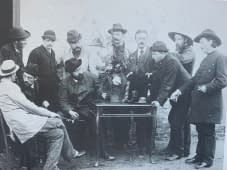The ram – a symbol of power (of creation) and resilience (Part 1)
Part 1: What distinguishes animals from humans...?
The sheep, which has been bred from various wild forms in different parts of the world since the Neolithic (8,500–4,500 BC), is the oldest known domestic animal along with the goat and the dog. In the Near East, domestication is even attested as early as the Old Babylonian period (19th–16th century BC). In addition to the obvious advantages of domesticated animals, such as being able to quickly obtain meat, milk, dung, wool and fur, sheep were often kept close to humans for religious contexts because of their nutritious preciousness. For today's «European-Western» view of humankind, the distinction between humans and animals is a central aspect, which is, however, unilaterally defined by humans. Thus, the human worldview is shaped by this distinction. How does this affect animals?
Animals are denied certain qualities that humans, conversely, acclaim for themselves, for example the ability to use tools or to produce art. The former was already scientifically refuted early on, because animals also use tools to make their lives easier. And is a bird's nest not architecture? Yet René Descartes' (1596–1650) words still stick with animals today when he determined that they cannot make individual decisions and their "behaviour is conditioned only by genetic programming" (Roters 2022, 10). The animal was thus something machine-like for Descartes. Jaques Derrida (1930–2004) resisted this in his written lecture «The animal that I therefore am» (French: «L'Animal que donc je suis») and defined a common characteristic for all living beings, namely the ability to be themselves, to be able to perceive the world through movement and stimuli and to ascribe an autobiography to themselves through these conditions – in other words, to engage with themselves and design their lives. Derrida recognises in life itself the commonality of humans and animals (vivant animal) and thus their connectedness, which is attempted to be separated by human constructs and simplifications, such as that of Descartes (cf. Roters 2022, 10). These imposed boundaries between human and animal are thus deconstructed in Derrida. As Roters notes, this categorisation of «human» and all others, the «non-humans», manifests anthropocentrism, a power relation imposed on animals.
Like so many other things that surround and shape human beings, animals have been a source of inspiration, motif, object and even material (think of parchment, for example) of human forms of expression. Often, they are or were even represented in it through their actual living or dead corporeality as active or passive performers and actors. (The ethical problems of using living animals in art are omitted from this discourse, but it certainly exposes the structures in which animals (have to) live.) Seen from this perspective, one justifiable way of representing animals in art is through artistic reproduction or representation. This can be in the form of pictures, traces of their former presence such as feathers, bones, faeces, fur, or as sculptures. The latter come very close to the physicality of the animals through their lifesize and shape. So, what do male sheep in art say about us humans, how were they depicted in the early days of human expression and how today?
The human exploration of the ram
The early preoccupation with animals is witnessed by cave paintings –- engraved, small-format animal and fantasy creatures, such as those in Lascaux, which were probably made 30,000 years BC, or the even older estimated image (40,000 BC) of a large hoofed animal in the cave of Lubang Jeriji Saléh on Borneo (cf. Roters 2022, 27–28). The oldest representations of rams in the form of clay reliefs with real horns are probably those from Çatalhöyük in today's Turkey, a settlement site with a cult complex that was mainly dedicated to a «mother deity» (7'000–6'000 BC). It is assumed that the rams' heads embody male fertility and belonged to ritual acts that focused on the maintenance of this «cosmic order». Equally possible, however, is the symbolisation as a provider of food (cf. Wunn 1999). Also remarkable are the stone ram figures in Uruk (Iraq), today Warka. Both smaller and larger stone rams' heads have been found there, but their symbolism has not been fully clarified.

In Old Europe, the oldest image of a ram dates back to end-Neolithic times. The figure, which is mostly described as the «clay ram of Jordansmühl» (Silesia, Poland) from the «Danubian culture», has striking Nordic ornaments, which indicate a contact zone of different cultures. The clay figure probably represents an image of a deity and was most likely part of an altar or cult niche (cf. Maringer 1980, 130–131).

In Late Neolithic and Copper Age cultures, many «ram-shaped cult vessels with an opening on the back» were discovered in the Middle Balkan region, which probably served as lamps, accordingly symbolising sunlight (Maringer 1980, 132).
The ram's relation to the sun is established in various cultures on the basis of the shape of its antlers. Small clay figures in the shape of rams were often given as grave goods, for example in the Gumelnitza culture in Romania. Clay figurines depicting rams were also found in the Swiss pile-dwelling settlement of Burgäschi-West, which were interpreted as children's toys or offerings to a deity. In Egypt, the ram was also associated with fertility, for example the creator god Chnum (cf. Maringer 1980, 132). He created gods, humans, animals and plants and was depicted as a human figure with a ram's head. Chnum inherited his power from the «potency of the ram». The word itself means «male sheep» (cf. Maringer 1980, 132). Amun, as the god of fertility, was also depicted with a ram's head in Egyptian culture; in contrast to Chnum, Amun was directly associated with a sun cult. Thus, he then also became the main god in Bronze Age Egypt (cf. Maringer 1980, 133).
In the Bronze Age, strange U-shaped objects made of clay or stone were found all over Europe. The ends of these so-called «fire dogs» were sometimes decorated with rams' heads – another indication of the importance of fire, which in turn was connected to the sun, the «heavenly hearth of fire» (Maringer 1980, 134). Among the nordic deities, too, a god was depicted with horns and in human form; this could be either Thor, the god of thunderstorms, or Heimdallr, god of light, who is thus linked to the sun (cf. Maringer 1980, 134). In the Iron Age, the Celts worshipped the ram, for whom it was also a symbol of power and fertility. This worship was based on «the ram's aggressiveness and procreative power» (Maringer 1980, 135). Aries figures made of clay or stone became more and more decorated over time, so that their original function became increasingly opaque. Concentric circles as design elements, however, continue to establish a solar reference. Such circles were also used as apotropaic means in Celtic culture. This protective power also explains the ram figures as grave goods to protect the deceased. With the influence of Roman and Hellenistic culture, the ram was not displaced; it was even integrated with the Roman gods. This is attested by a Mithras sanctuary in Königshofen near Strasbourg, where a stone with a ram's head was found next to an Attis altar (cf. Maringer 1980, 135).
So, we have now set out to trace the animal in human art and culture. But why do humans look for anthropological characteristics in animals when they try to distinguish themselves from them in modern times? If you want to learn more about the meaning of animal figures, then look forward to the second part.
Glossary part 1:
Vivant animal: Term of the philosopher Derrida. By this he means a living being (living beings, animals) that can ascribe an autobiography to itself, i.e. can influence itself.
Anthropocentrism: From Latin «ánthrōpos» for «human being» and «centrum» for «centre». This is a system that places humans at the centre, making them the measure of all things. This neglects the importance and perspective of other living beings and nature, which receive their «value» only in relation to the human being.
Fire dogs: A frame that is placed in a fireplace on which the firewood is placed. This elevation improves the air supply, so that the wood burns better and hotter. Archaeological finds resemble these modern firedogs, but it is not conclusively clear whether their function is identical, nevertheless they are called so. In German they are also called «fire rams».
Mithras: A Roman deity who personifies the sun and was worshipped in Mithraism (mystery cult in the Roman Empire since the 1st century AD). However, there is evidence of the cult as early as the 2nd century BC in the North Indian and Iranian cultures, where Mithra is a god of light.
Attis: son of the river nymph Nana, who was raised by a goat with goat's milk. In the Roman cult of the dead, Attis was depicted on tombstones, where he symbolised mourning.
picture credits:
Image 1_Fragment of a ram's head, 2800-2700 BC, Djemed-Nasr period, stone limestone, found in Warka (formerly Uruk), Staatliche Museen zu Berlin, Vorderasiatisches Museum / Photo; Olaf M. Teßmer CC BY-NC-ND 4.0.
Image 2_Jordansmühl ram, ca. 4300 to 3'900 BC, Jordansmühl culture, Photo: Heidelberg University Library, bequest of Ernst Wahle.
cover_The Met Museum. Terracotta oil lamp, 1st century B.C. - 1st century AD.








